Trees Birds Mammals Fish Amphibians Reptiles
Wild Algarve
Bookshop
Fuscoporia torulosa (Pers) T. Wagner & M. Fisch. - Tufted Bracket
Phylum: Basidiomycota - Class: Agaricomycetes - Order: Polyporales - Family: Hymenochaetaceae
Distribution - Taxonomic History - Etymology - Identification - Culinary Notes - Reference Sources

Bracket fungi do not generally score highly in fungal beauty contests, and the Tufted Bracket (this is its Mediterranean common name, but it has also been included in the British Mycological Society's list of English names of fungi despite the fact that this species is seldom recorded in Britain and Ireland) is no exception. Seen from the top these brackets are like Nature's litter bins, with dead leaves, twigs, acorns and other moss-covered debris. Below is a view of the debris-filled cap of the specimen pictured at the top of this page.
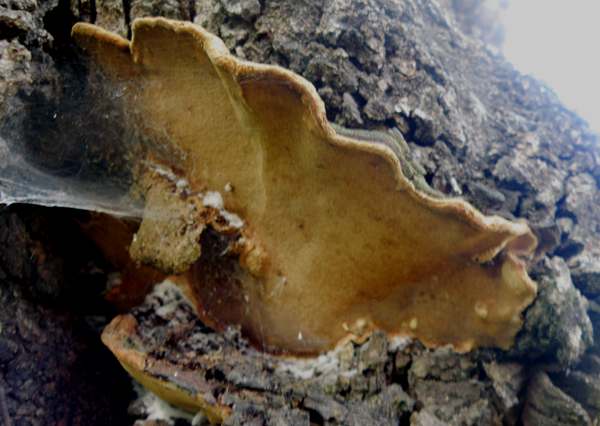
I keep hoping to find a more photogenic specimen, but spiders' webs, mosses and algae invariably adorn these perennial brackets long before I stumble across them.
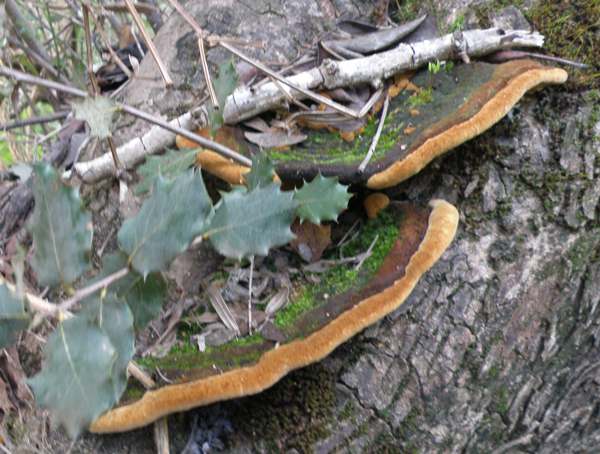
Distribution
Fuscoporia torulosa is very rare in Britain but common in southern Europe, particularly in Mediterranean countries. This species has also been recorded in parts of North America.
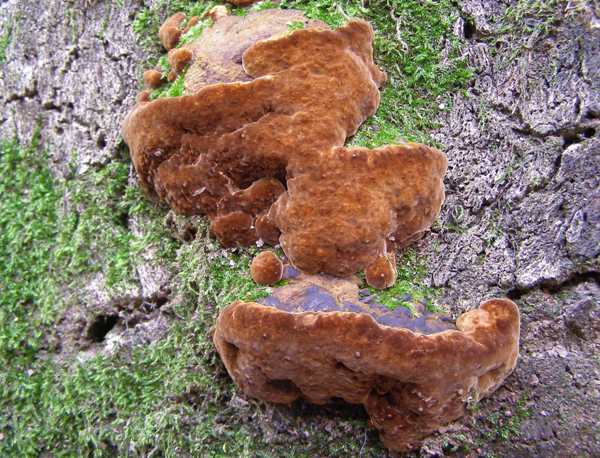
Taxonomic history
Christiaan Hendrik Persoon established the basionym of this species in 1818 when he described it under the scienific name Boletus torulosus Pers.,The currently-accepted scientific name Fuscoporia torulosa dates from a 2001 publication by German mycologists T Wagner and M Fischer.
Synonyms of Fuscoporia torulosa include Boudiera rubripora (Quél.) Lázaro Ibiza, Fomes castaneae Woron., Fomes ceratoniae (Lázaro Ibiza) Sacc. & Trotter, and Phellinus torulosus (Pers.) Bourdot & Galzin.
Etymology
Many field guides include this species under its synonymous scientific name Phellinus torulosus. In 1886 the genus Phellinus was circumscribed by French mycologist Lucien Quélet; that generic name comes from phell- meaning cork, while the suffix -inus denotes a superlative. The implication, therefore, is that fungi in the genus Phellinus are the most cork-like (the toughest) of them all. The genus Fuscoporia was established in 2007 by American mycologist William Alphonso Murrill (1869 - 1957); the genus name comes from the Latin adjective fusca meaning dark brown, and is a reference to the dusky (dark brown) pored surface of this polypore. The specific epithet torulosa comes from the Latin torosus or torulosus and means 'cylindrical with periodic knots, bulges and contractions'.
Identification guide
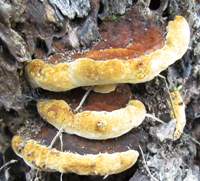 |
Fruitbody
Sessile (stemless) brackets, sometimes in tiers, grow to between 15 and 40 cm wide; they are laterally attached to tree trunks near their bases.
The upper (infertile) surface is dark brown and velvety, with a lighter tan to russet-brown, finely-velvet rounded margin. Often the upper surface of older brackets is covered at least partly in leaves, woody debris, mosses and algae making this an easy fungus to miss. |
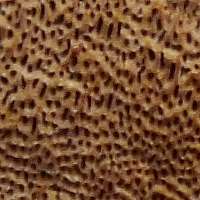 |
Tubes and Pores
The lower (fertile) surface is irregular but mostly covered in hymenial (spore-producing) tubes and pores. The tubes are brown, 2 to 8mm deep and they terminate in small roundish red-brown pores 0.1 to 0.2mm in diameter spaced at 4 to 6 per mm. |
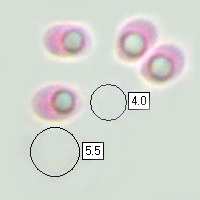 |
Spores
Ellipsoidal, smooth, thin-walled, hyaline, 4-6 x 3-4μm; inamyloid.
Spore print
White. |
Odour/taste |
Not significant. |
Habitat & Ecological role |
Saprobic or weakly parasitic on broadleaf (hardwood) trees and in particular on oaks, olives, mastic trees and heathers. This bracket fungus is often seen on Carob trees; these brackets are invariably found near the base of the trunk. |
Season |
Perennial, releasing spores throughout late summer, autumn and early winter. |
Similar species |
Fomes fomentarius is hoof shaped with an overall grey appearance; it attacks mainly birches in Britain and Ireland. |
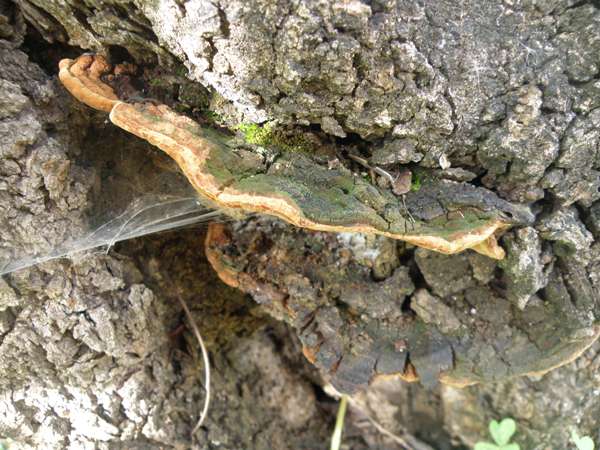
Culinary Notes
Fuscoporia torulosais an extremely tough inedible fungus - even removing one of these brackets from a tree requires a saw and would consume far more calories that would be obtained if you managed to chew and swallow it.
It seems unlikely that Tufted Bracket contains deadly toxins, because according to Tom Volk closely related species were chewed as tobacco substitutes, but we know of no cooking recipes for this undistinguished bracket fungus.
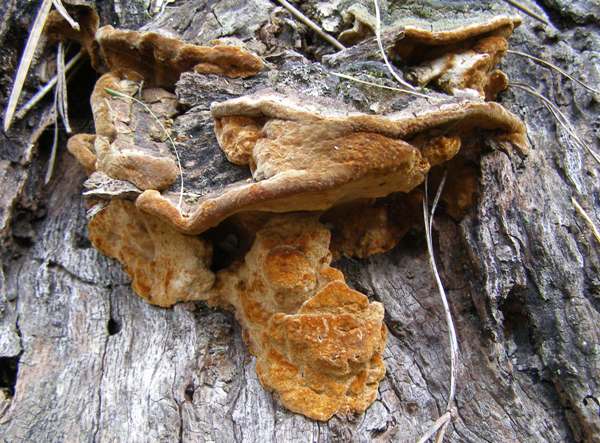
Reference Sources
Bourdot & Galzin (1925), Bulletin de la Société Mycologique de France 41: 191
Dictionary of the Fungi; Paul M. Kirk, Paul F. Cannon, David W. Minter and J. A. Stalpers; CABI, 2008
Wagner T, Fischer M. (2001). Natural groups and revised system for the European poroid Hymenochaetales (Basidiomycota) supported by nLSU rDNA sequence data. Mycological Research 105: 773–82.
Taxonomic history and synonym information on these pages is drawn from many sources but in particular from the British Mycological Society's GB Checklist of Fungi.
Top of page...
Fascinated by Fungi. Back by popular demand, Pat O'Reilly's best-selling 450-page hardback book is available now. The latest second edition was republished with a sparkling new cover design in September 2022 by Coch-y-Bonddu Books. Full details and copies are available from the publisher's online bookshop...